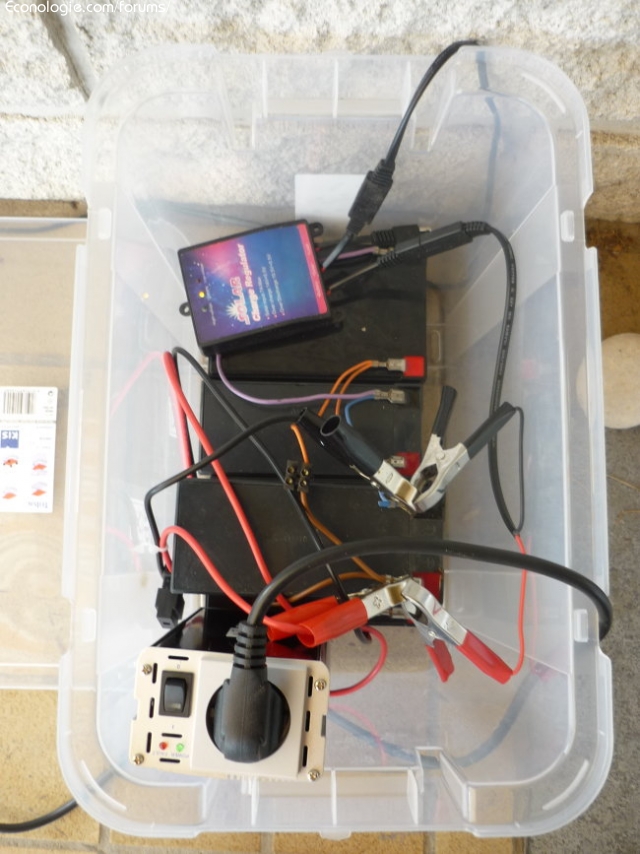Presentation of our electric bike recharged at solar
This assembly is based on the bike foldable electric assistance we bought in the spring 2009. Here is a subject that has this Folding Electric Bike.
We have equipped it with a small “trailer” to increase the load carrying capacity (almost zero without except a backpack) and thus make it much more “utilitarian”. During the summer we used it regularly to bring parcels from the eco-friendly shop to the Post Office.


This bike, with its trailer has cost 510 euros. You will find all the technical details of this electric bike here.
Why a solar charging kit?
To show that it was possible to make a vehicle with a real ZERO IMPACT (neither carbon nor nuclear) for a very reasonable price!
Indeed, everything costs less than € 750: bike + trailer € 390 120 € + charging station approximately € 220.
So in order to disconnect completely from the electrical “network”, we made a small solar assembly in order to solar recharge the Li-Ion battery of the bike.
This solar assembly is based on lead-acid buffer batteries which constitute a “solar energy reservoir”.
These batteries are essential because the instantaneous power requested by the solar charger (80W) would have required too much investment in solar panel and above all would have allowed the bike to be charged only directly. That is, when the sun is shining, which is not an acceptable option in the case of “off-board” solar charging.
In addition, the recharging of Li-Ion batteries, unlike that of lead batteries, must be very rigorous and requires a specific charger. In our case we continued to use the original one. It is supplied with 230V AC and therefore requires an inverter since the buffering in lead batteries is done at 12V.
Detailed elements of the solar kit
All the products in the "solarization kit" (except the inverter that can be found anywhere) come from the econological store, solar ray:
- 2 amorphous silicon panels of 5W in parallel
- 1 solar regulator 12V

Test setup
Here is a photo of the test setup:

From left to right:
a) The Li-Ion battery of the bike: 24V 8Ah = 24 * 8 = 192 Wh stored
b) Li-Ion charger supplied with the bike
c) The inverter 12V to 230VAC with modified sine (false sine) of 300W
d) 2 cyclical 12V 7Ah lead batteries that serve as buffer = 2 12 * * = 7 168 Wh stored (2 other batteries of 12Ah will be added in the final cut)
e) above, truncated, the solar controller
Two galvanometric ammeters have been added in order to see the input amperages (from the solar panels) and output (to the inverter):

It reads (full sun)
a) full deviation on solar input i.e. at least 7W solar input
b) Just over 6 A consumption: approximately 6.2 12 * V = 75W output.
We can immediately see (power ratio of 10) that we could not recharge directly unless we have 10 times more power from solar panels, therefore 10 times more investment in panels.
Lead acid batteries are essential!
Depending on the amount of sunshine the input amperage obviously varies, a day without sun, cloudy but quite clear gives between 100 and 200 mA, it is weak but it is "always good to take"!
final assembly
A few days later, the "final" assembly was carried out by adding 2 batteries of 12Ah. Total capacity of the charging station = 2 * 7 + 2 * 12 = 38 Ah, i.e. under 12V, 456 Wh. This is much more than is necessary but allows during each cycle not to make a “deep” discharge of the lead batteries and thus increase their lifespan.
Here is the "solar charging station":


Performance analysis and reflections
The Li-Ion charger goes out (during the 1st phase of recharging a LiIon battery = high amperage) at max: 1.8 A at 29.4 V = 53W in the Li-Ion battery of the bicycle.
The inverter and charger efficiency is therefore 53/75 = 70% which is quite honorable since there are 2 transformers in series and we go through 230V AC.
This gives an efficiency per root transformer of 0.7 = average efficiency per transformer of 84%. It is very good.
It takes 4h30 for a full charge.
Reflexions for improvements (next?)
a) Some will say that it is stupid to make 230V AC from DC to redo DC and they will be right but I do not (for the moment) have a Li-Ion 12V charger ... (if a reader has a address I'm interested in, contact us via the forum!)
b) When you plug the Li-Ion charger into the inverter, it "buzzes". Is this detrimental to its lifespan, we will see in use.
c) This method requires the use of buffer batteries, which wear out and pollute. Yes, but if we want to stay within a reasonable investment, we have no choice.
In addition lead batteries permanently charged "12h / 24h" have a lifespan surely more interesting than heavily used batteries. And the fact of putting several batteries and increasing the buffer capacity (compared to needs) also increases their lifespan (no deep discharge).
Anyway, solar charging works and drives in all "independence" for a very low investment and while doing a little sport is a real pleasure !!
In summer, 2 loads per week are possible with 2 panels 5W.
More:
- solar charging of an eBike
- Presentation and technical details of this electric bike


Hello! what about after all these years? According to you, would such a system be possible to pull a child weighing over 20 kg in a steep and long climb (20min) twice a day?
Thank you for the great idea !!
Does it really work like that?
If so, that's amazing!